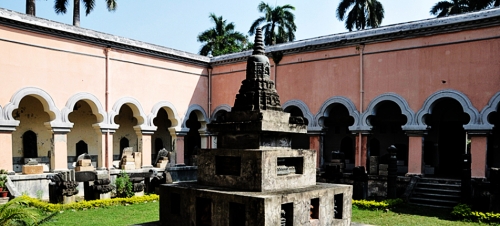
Barind Research Museum, Rajshahi.
The Barind Research Museum is located at Hetem Khan, the heart of the Rajshahi metropolis. This is the first museum in Bangladesh. It is one of the archeological collections in South Asia. Sarat Kumar Roy, zamindar of the Dighapatiya royal family of Natore, lawyer Akshay Kumar Maitreya and teacher of Rajshahi Collegiate School Ramprasad Chandra have made significant contributions to the establishment of the Barind Museum. In 1910, they formed the Barindra Research Society for the collection and preservation of Bengali heritage and artefacts. In that year, they searched various places in Rajshahi and collected 32 rare specimens. Construction of the museum’s own building began on land donated by Sarat Kumar Roy to preserve these artifacts. Construction was completed in 1913 AD. The museum was inaugurated by the then Governor of Bengal Carmichael on 13 November of the same year.
The foundation stone laid by Lord Carmichael
In 1911, the Calcutta Museum suddenly demanded all the artefacts preserved in it. At the initiative of the then Governor Carmichael, the Barind Museum was given the authority to collect and preserve its artefacts through an official notification issued on 14 February 1913.
In 1923, Calcutta University jointly with the museum authorities began excavations at the Paharpur Buddhist Monastery in Naogaon. Later, 258 specimens were discovered from Paharpur in a single effort of the Barind Research Society. After 1947, there was a crisis over the existence of the museum. From 1949 to 1961, half of the museum building was used as a medical school. When the museum was about to close in 1974, its movable and immovable property was acquired by the Rajshahi University on October 10 of that year. [4]
Patterns
The collection of Barind Museum is more than 9 thousand. There are traces of the Indus Valley Civilization thousands of years ago. The museum’s invaluable collection includes archeological artefacts from the Mohenjodaro civilization, stone statues, Buddha statues dating to the 11th century AD, the head of Bhairab, and the Ganges. The silver coins of the Mughal period, the round gold coins of the Gupta emperor Chandragupta, the round silver coins of the emperor Shahjahan are particularly noteworthy. There are about 5000 manuscripts out of which 3648 are in Sanskrit and the rest are in Bengali. Paintings from the Pala period to the Muslim period, painted by Imad-ud-Daulah, Nurjahan’s father.